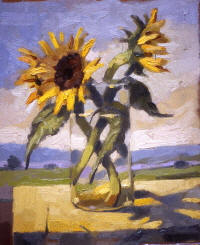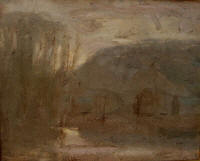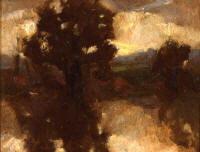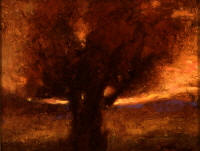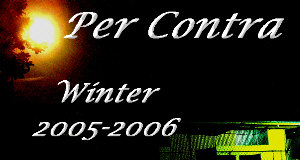
Al Gury
He writes for American Artists and is working on a book about painting technique.
Images on
right open to larger versions when clicked.
Adam and Eve
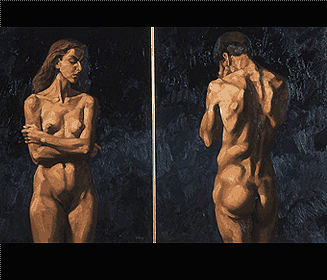
Al Gury An Interview by Miriam N. Kotzin
MNK: You once mentioned to me that your parents had a portrait painted of you, and in that portrait you were depicted drawing. Did you ever consider any other life for yourself other than being an artist--and, a teacher of art?
AG: Well, the title "artist" has always sounded very exalted to me-something I aspired to be when I grew up, which I'm still hoping for by the way. I usually refer to myself as a painter. Then people think I paint houses. Oh well...I daydreamed about lots of futures: veterinarian, writer, doctor, farmer, priest, sex object. When I got to college, and took my first life drawing class, I think I never had a second thought about anything else. Or any thoughts at all-I just went with it. Now, it's like the military or a long marriage, every so often I "re-up" and keep going.
MNK: Who were the teachers or artists that had an influence on your work? What have you done to keep their influence but develop your own style? Was that conscious?
AG: Influences come in funny forms. Sometimes they have a direct and visible stylistic influence, and sometimes they are a subtle quality of flavor that helps add up to something else. There were four individuals in my life who had a direct influence on my development. The first was a woman, Grace Correll, who was a family friend and the only real artist in our Midwest town. She was an impressionist landscape painter who would go out and stand on the bluffs overlooking our river and paint in the wind and the sun. She taught me how to stretch my first canvas and would critique my pathetic adolescent efforts at painting in acrylics. The second was Tom Toner. Tom was the head of the art department at St. Louis University, where I went to college. He was a gifted painter from the Pennsylvania Academy of the Fine Arts who gave me a model of what I thought a real painter was. He didn't really teach much, but he allowed us to come into his studio and watch him paint and breath the humid atmosphere of nude models, paintings in progress and Renaissance painters. The third and fourth came at the same time. Coming to Philadelphia and the Pennsylvania Academy at 20 years old, thanks to Toner, I met what I call the "real deal". In 1972 the art world on the East Coast at that time was still populated by painters who had been trained in the 20's through the fifties. Some even earlier were still alive. Most of them are gone now, but I absorbed their stories and atmosphere and the romance of it all like a soft moist sponge.
The social movements of the sixties and early seventies were in full swing, but there werue many parallel universes in the art world that I was learning just as fast. Arthur DeCosta and Eleanor Arnett couldn't have been more unalike if they had been created by a fiction writer. Arthur was a romantic classicist who was steeped in the aesthetics of the 16th century Italian and 18th century British painters. As an august personage on the Academy faculty (one of may strong characters from the pre-seventies art world) he taught the craft of painting with consummate elegance and good sense. DeCosta drew students to him like moths dazed by the light of a flame. He was a kind of gentleman/scholar/painter, connoisseur and dedicated teacher that was never common and is even rarer now. He was a cool, distant father figure who taught me how to paint and how to teach. Eleanor Arnett had attended the Pennsylvania Academy of the fine Arts in the early thirties. A woman who intended to be herself no matter what, she associated herself with women painters who are now known as "the Philadelphia Ten", and "the Red Rose Girls". Starting as a camouflage painter in WWI, she went on after the Academy to study with Hans Hoffman in Munich. She later, along with Mr. Barnes, helped Hoffman get settled in the US. Elearnor was an uncompromising painter of modernist truth. Unlike DeCosta, to her the visual world was full of interesting abstract shapes, textures and colors that were ripe for composing on the picture plane. I was sent around from the Academy by her friend Ethel Ashton, our librarian and a friend of Alice Neel, to work for Eleanor doing errands, delivering paintings to shows, etc. In her late seventies then, I heard from her the whole saga of the 20th century from the Edwardian era to the post WWII brave new world. She "taught" by drawing on my small paintings to show me a point of composition, space or design. Unlike DeCosta's formal exercises, painting was a journey, and the painting could be reinvented or changed at any moment. Between the two of them, I got a strong dose of "the real deal".
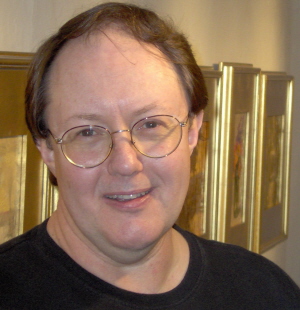
MNK: You've painted still life, landscape and the figure as well as portraits. What are the satisfactions of each? The challenges? We know that Sargent said that "A portrait is a painting in which there's a little something wrong with the mouth." Besides getting the likeness, what is the challenge of portraiture?
AG: I know many painters who have one theme or subject that they pursue over and over. Faced with having many influences in my life from symbolic to naturalistic and abstract to representational, I had to create a synthesis and make many choices as I went along. The danger is not focusing on any one thing long enough to really explore it, or worse, not do anything because of feeling unable to make up ones mind. Somehow, I've been able keep it all working and pull things together. I love the shapes, tonalities and colors of things above all. Tonality and color join together as one element and the whole thing is brought out by the richness and sensuality of the paint itself and drawing with the paint. Poetic harmonies and suggestions of narratives or symbols are very important as well. It's a tough balance that has to be watched and guided, edited and adjusted constantly during the development of a painting. I've always painted the figure and portraits, and lately lots of landscapes and still lifes. I find the elements I love in all of them. I sometimes verge on abstraction and paint abstractions occasionally.
MNK: Your painting style has changed a good bit over the last decade. How would you describe the changes? Do you know why your work has changed like that?
AG: An artist friend, Gillian Pederson-Krag, did a lecture showing the childhood and youthful drawings of many artists along side their mature work. The point was that often the adult painters found their way back in their mature work to their original and more personal themes and images of their childhood. In many ways I have also. My first remembered drawing was a landscape taught to me by my Grandmother. I can still draw it and sometimes do. My first paintings were thickly painted and brushy and were subjects I really cared about. In college, I learned to admire fine smooth painting like that of the 16th C. and later of the French classicists like Ingres. After being exposed to a broader art world on the east coast, I found my way back to a love of the paint itself and color. It's taken a long time though to put together all the elements of image, tone, color, paint, drawing, impact, poetry, etc. in one relatively small rectangle. I'm not there yet, but there's still hope that I'll get closer to the things I cared about as a child.
MNK: You're now chair of the painting department at the Pennsylvania Academy of Fine Arts, the bastion of figurative art, the place where you went to art school and from which you received the prestigious Cresson award. How does your own teaching -and the demands of administration--affect the way that you work?
AG: Well, when I decided I really liked to teach after I got out of college and the Academy, and before graduate school, I took a risk that most practicing painters have to face - finding the energy for both teaching and painting. It's a tough balance if you love both, but I decided after a while that they fed each other. When I'm with my students at the Academy, I get very excited about painting and what they're doing. They come into my studio at school and see what I'm working on and take away ideas, and I see things they are doing and want to try something triggered by their explorations. As anyone in any college or university will tell you, the hard parts are the meetings and the paperwork. I just try to keep focused on the real reason we are all doing this - to make the best art we can and to bring it into the future. Sounds idealistic, but at the Academy, it's not a difficult concept to find. I no longer feel that I have to have ideal time slots to paint - I just do the work in the time I have and make that work. I get up before dawn, write for awhile, then paint for an hour or so and then go to school for the day. Some days are mostly free for painting and some are not-you just find a rhythm and do the work as if it's all the same thing. I think of myself as a workman going to work every day, only, my work is art.
MNK: You teach all ages from high school to adult, some who are preparing for careers as artists, others who do not. How would you describe your teaching as it relates to your own painting? You talk about technique and the history of art and critique students' work from morning to night--can you think of ways in which that makes your painting "better" (whatever that means)? Do you ever find yourself fighting an internal critic as you paint? How do you turn that off?
AG: Generally, I would say that teaching balances my painting very well, and vice versa. Some painters feel that teaching is a necessary evil to support their real work. I've never felt that way. Maybe it's because most of the really good painters I admired also taught. Teaching concepts, techniques, aesthetics or art history makes me think more about what I'm doing in my work and where I'd like to go with it. I learn from the students-someone will do a particularly interesting thing in paint in class, and I'll think "wow, I want to try that as soon as I can". The only real difficulty is the frustration of not being able to walk into the studio and paint, instead of teaching others how to do it all day. There'll be a particularly wonderful pose that the model has taken in class, and I can't paint it. Some teachers do paint in their classes, but I don't. I do extensive demonstrations for the classes but that's different from doing a piece of work that way I would do it alone in my studio. That can be frustrating. The demonstrations that are a hallmark of my teaching help me feel connected all the time to painting. An internal critic? It's always there gnawing away and making small comments in the background. Hard to turn off, but it can be done. When it's loud and obnoxious, I'm usually feeling unsure and at cross purposes while painting. That's when I may end up scraping a passage out or even restart the whole painting. It's a strange mix of self confidence and internal criticism that makes it happen. Getting the balance is what artists have struggled with forever.
MNK: What non textbooks about art would you recommend for someone who wants to learn about the history of art?
AG: Robert Henri's The Art Spirit, Chaim Potok's My Name Is Asher Lev.
MNK: What question should I have asked you that I forgot to ask? Will you answer it?
AG: Why do I paint? Ultimately, simply, because I like it. It's hard work, but I really enjoy smearing paint around and drawing. Once when I thought about giving it up, I said "wait a minute, I really like doing this. OK, so what do I like to paint? OK, so paint that, not some thing I thought I "should " paint. It's a miracle to do what I get to do and have the life I have.
Images By Al Gury
Click the Image to View Full Sized
Tuscan Flowers
River Mist
